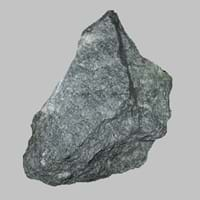Definition
Mylonite is a metamorphic rock formed by ductile deformation during intense shearing encountered during folding and faulting, a process termed cataclastic or dynamic metamorphism
It is a metamorphic magnesium rich rock because it is composed of the mineral talc
Discoverer
Unknown
Unknown
Etymology
From Greek mulōn mill + -ite
From 17th century, because of its greasy feel and use like a soap
Class
Metamorphic Rocks
Metamorphic Rocks
Sub-Class
Durable Rock, Medium Hardness Rock
Durable Rock, Soft Rock
Group
Not Applicable
Not Applicable
Other Categories
Fine Grained Rock, Opaque Rock
Fine Grained Rock, Opaque Rock
Texture
Foliated
Polished
Color
Black to Grey
Black, Black to Grey, Green, Grey
Durability
Durable
Durable
Appearance
Dull, Banded and Foilated
Dull, Banded and Foilated
Interior Uses
Decorative Aggregates, Interior Decoration
Bathrooms, Decorative Aggregates, Homes, Interior Decoration
Exterior Uses
As Building Stone, As Facing Stone, Paving Stone, Garden Decoration
As Facing Stone, Garden Decoration
Other Architectural Uses
Curbing
Curbing
Construction Industry
for Road Aggregate, Landscaping, Roadstone
Manufacture of Magnesium and Dolomite Refractories
Medical Industry
Not Yet Used
Taken as a Supplement for Calcium or Magnesium
Antiquity Uses
Artifacts, Monuments
Artifacts, Jewellery, Monuments, Sculpture
Commercial Uses
Creating Artwork, Gemstone, Jewelry
Cemetery Markers, Creating Artwork, Gemstone, Jewelry, Manufacture of Soap, Solvents, Dyes, Plastics and Fibres, Production of Lime, Source of Magnesia (MgO)
Types
Blastomylonites, Ultramylonites and Phyllonites
Not Available
Features
Surfaces are often shiny
Host Rock for Lead
Archaeological Significance
Famous Monuments
Data Not Available
Christ the Redeemer in Rio de Janeiro, Stonehenge in English county of Wiltshire
Famous Sculptures
Data Not Available
Data Not Available
Formation
Mylonites are ductilely deformed rocks formed by the accumulation of large shear strain, in ductile fault zones.
Soapstone is a talc-schist, which is a type of metamorphic rock and it is largely composed of the mineral talc and is thus rich inmagnesium.
Mineral Content
Porphyroblasts
Albite, Apatite, Biotite, Calcite, Carbonate, Clay Minerals, Hornblende, Ilmenite, Micas, Plagioclase, Pyroxene, Quartz
Compound Content
Aluminium Oxide, Calcium Sulfate, Chromium(III) Oxide, Iron(III) Oxide, Magnesium Carbonate, Silicon Dioxide
CaO, Mg, MgO
Types of Metamorphism
Not Applicable
Burial Metamorphism, Cataclastic Metamorphism, Contact Metamorphism, Hydrothermal Metamorphism, Impact Metamorphism, Regional Metamorphism
Types of Weathering
Biological Weathering, Chemical Weathering, Mechanical Weathering
Not Applicable
Types of Erosion
Chemical Erosion, Sea Erosion, Wind Erosion
Not Applicable
Grain Size
Fine Grained
Fine Grained
Fracture
Conchoidal
Conchoidal
Porosity
Highly Porous
Less Porous
Cleavage
Conchoidal
Perfect
Toughness
Not Available
1
Specific Gravity
2.97-3.05
2.86
Transparency
Opaque
Opaque
Density
2.6-4.8 g/cm3
2.8-2.9 g/cm3
Resistance
Heat Resistant, Impact Resistant, Pressure Resistant
Heat Resistant, Pressure Resistant
Deposits in Eastern Continents
Asia
China, India, Indonesia, Saudi Arabia, South Korea
China, India, Indonesia, Japan, North Korea, Russia, Saudi Arabia, Singapore, South Korea, Sri Lanka, Tajikistan, Thailand
Africa
Eritrea, Ethiopia, Ghana, South Africa, Western Africa
Egypt, Ethiopia, Ghana, South Africa, Western Africa
Europe
England, Finland, France, Germany, Great Britain, Greece, United Kingdom
Austria, England, Finland, France, Germany, Greece, Spain, Sweden, Switzerland, United Kingdom
Others
Not Yet Found
Not Yet Found
Deposits in Western Continents
North America
USA
Canada, USA
South America
Not Yet Found
Colombia
Deposits in Oceania Continent
Australia
Central Australia, Western Australia
Central Australia, New Zealand, Queensland
All about Mylonite and Soapstone Properties
Know all about Mylonite and Soapstone properties here. All properties of rocks are important as they define the type of rock and its application. Mylonite and Soapstone belong to Metamorphic Rocks.Texture of Mylonite is Foliated whereas that of Soapstone is Polished. Mylonite appears Dull, Banded and Foilated and Soapstone appears Dull, Banded and Foilated. The luster of Mylonite is shiny while that of Soapstone is greasy. Mylonite is available in black to grey colors whereas Soapstone is available in black, black to grey, green, grey colors. The commercial uses of Mylonite are creating artwork, gemstone, jewelry and that of Soapstone are cemetery markers, creating artwork, gemstone, jewelry, manufacture of soap, solvents, dyes, plastics and fibres, production of lime, source of magnesia (mgo).










